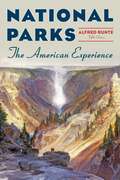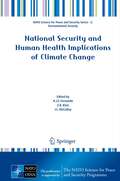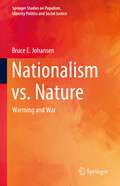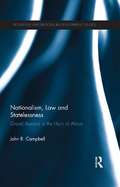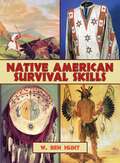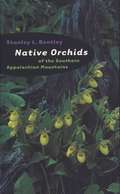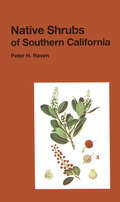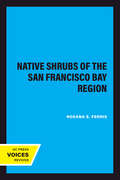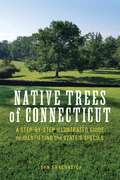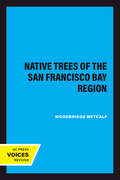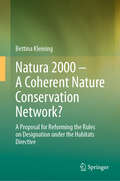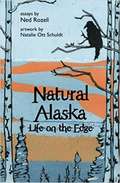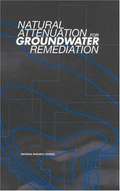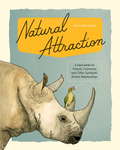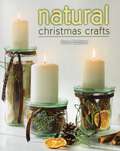- Table View
- List View
National Parks: The American Experience
by Alfred RunteRevised with a new epilogue, &“We the People,&” this fifth edition of National Parks: TheAmerican Experience continues the highly engaging story of how Americans invented and expanded the concept of national parks. A prominent adviser to the Ken Burns Emmy Award-winning documentary, "The National Parks: America's Best Idea," Alfred Runte is renowned as the nation's leading historian on the meaning and management of these treasured lands. Further supported with period photographs and now twelve pages of color paintings, National Parks remains a stirring look into the lands that define America, from Yosemite and Yellowstone to wilderness Alaska. This is how we got our parks, and looking to the future, the challenges that remain in preserving them. Are &“we the people&” still up to the task? Yes, this history advises, but only if we consistently cherish the national unity that our commitment to the parks further demands.
National Security and Human Health Implications of Climate Change
by Harindra Joseph Fernando J. L. Mcculley Z. B. KlaićClimate change has been identified as one of the greatest threats to humanity of all times. In addition to producing adverse environmental conditions such as rising sea level, drought, crop failure, vector-borne diseases, extreme events, degradation of water/air quality and heat waves, climate change is also considered a threat multiplier that leads to local and international conflicts and armed interventions. Urban areas may bear the brunt of climate change, as they are the centers of human habitation, anthropogenic stressors and environmental degradation, and the ensuing health impacts are of grave societal concern. The papers in this volume span a suite of climate change repercussions, paying particular attention to national security and human health aspects. It is an outcome of a NATO Advanced Research Workshop held during April 28-30, 2011 in Dubrovnik, Croatia, sponsored by the NATO Science for Peace and Security Program. The contributions cut across the elements of modeling, natural, political and social sciences, engineering, politics, military intervention, urban planning, industrial activities, epidemiology and healthcare.
National Water Resources Challenges Facing the U.S. Army Corps of Engineers
by Engineering Committee on U.S. Army Corps of Engineers Water Resources Science PlanningThe U. S. Army Corps of Engineers (Corps) is responsible for construction, operations, and maintenance of much of the nation's water resources infrastructure. This infrastructure includes flood control levees, multi-purpose dams, locks, navigation channels, port and harbor facilities, and beach protection infrastructure. The Corps of Engineers also regulates the dredging and filling of wetlands subject to federal jurisdictions. Along with its programs for flood damage reduction and support of commercial navigation, ecosystem restoration was added as a primary Corps mission area in 1996. The National Research Council (NRC) Committee on U. S. Army Corps of Engineers on Water Resources Science, Engineering, and Planning was convened by the NRC at the request of the Corps of Engineers to provide independent advice to the Corps on an array of strategic and planning issues. National Water Resources Challenges Facing the U. S. Army Corps of Engineers surveys the key water resources challenges facing the Corps, the limits of what might be expected today from the Corps, and future prospects for the agency. This report presents several findings, but no recommendations, to the Corps of Engineers based on initial investigations and discussions with Corps leadership. National Water Resources Challenges Facing the U. S. Army Corps of Engineers can serve as a foundational resource for the Corps of Engineers, U. S. Congress, federal agencies, and Corps project co-sponsors, among others.
Nationalism vs. Nature: Warming and War (Springer Studies on Populism, Identity Politics and Social Justice)
by Bruce E. JohansenDeveloping an original approach, this book examines how both nationalism and climate change threaten humankind with future catastrophes, arguing that humanity is on a fast track to a dystopian future unless significant changes are implemented. While the world warms, wars driven by nationalism may lead to worldwide devastation, with humankind being caught between two existential threats of its own creation. The author explains how both nationalism and climate change originate from human ingenuity and can only be answered by human cooperation. While, in a perfect world, such problems already would have been solved by the United Nations, this isn't the case in reality. The book discusses how humanity’s many peoples can cooperate to a degree necessary to retain mutual respect without war, in the interest of achieving long-term change which will use technology for mutual good, also “dodging the bullet” of climate change. Offering an outlook into a possible better world, the author also analyzes the massive changes required for everyone to face, discuss, and solve the problems at hand. The book will appeal to students, scholars, and researchers of political science, international relations, and environmental sciences, as well as practitioners and a general audience interested in the study of nationalism, diplomacy, wars, and climate change.
Nationalism, Law and Statelessness: Grand Illusions in the Horn of Africa (Routledge Explorations in Development Studies)
by John R. CampbellIn 1998 a bloody war erupted in The Horn of Africa between Ethiopia and Eritrea. During the war Ethiopia arrested and expelled 70,000 of its citizens, and stripped another 50,000-plus of their citzenship on the basis of their presumed ethnicity. Nationalism, Law and Statelessness: Grand Illusions in the Horn of Africa examines the events which led up to the war, documents the expulsions and denationalisations that took place and follows the flight of these stateless Ethiopians out of the Horn into Europe. The core issue examined is the link between sovereignty and statelessness as this plays out in The Horn of Africa and in the West. The book provides a valuable insight into how nations create and perpetuate statelessness, the failure of law, both national and international, to protect and address the plight of stateless persons, and the illusory nature of nationalism, citizenship and human rights in the modern age. The study is one of a very few which examines the problem of statelessness through the accounts of stateless persons themselves. This book will be of great interest to students and researchers in anthropology, law, politics, African studies and refugee studies as well as professionals and all those interested in stateless persons in the West, including Eritreans, who continue to be denied basic rights.
Nationalization, Natural Resources and International Investment Law: Contractual Relationship as a Dynamic Bargaining Process (Routledge Research in International Law)
by Junji NakagawaNationalization disputes in natural resources development are among the most disputed issues of international investment law. This book offers a fresh insight into the nature of nationalization disputes in natural resources development and the rules of international investment law governing them by systematically analyzing (1) the content of investment contracts in natural resources development, and (2) the results of nationalization disputes in natural resources development from the perspective of dynamic bargaining theory. Based on the comprehensive and systematic empirical analyses, the book sheds new light on contractual renegotiation and renewal as a hardly known but practically normal solution of nationalization disputes and presents a set of soft law rules governing contractual renegotiation and renewal.
Native American Survival Skills: How To Make Primitive Tools And Crafts From Natural Materials
by W. Ben HuntW. Ben Hunt, whose Sioux name was Tasunka Witko, traveled throughout the Midwest, living with several Native American tribes, finally settling near the site of the last Sioux uprising. Here he provides step-by-step instructions and exact dimensions to make Sioux ghost shirts, Plains Indian shields, box traps, Iniut snowshoes, and more. From making rawhide to putting the finishing touches on a pair of moccasins, beginners and seasoned woodsmen alike will enjoy making the tools and camp equipment that were used for centuries. Native American Survival Skills is a remarkable source of information about the Americans who first pioneered self-sufficient living. In it, there are lessons for all of us today.
Native Orchids of the Southern Appalachian Mountains
by Stanley L. BentleyThis authoritative guide showcases the unmatched beauty and diversity of the native orchids of the southern Appalachian mountains. Based on Stanley Bentley's many years of nature study, it covers the 52 species--including one discovered by Bentley and named after him--found in a region encompassing western Virginia and North Carolina and eastern West Virginia, Kentucky, and Tennessee.The entry for each orchid provides the plant's scientific and common names, a description of the flower (including color, shape, and size), and information on the time of flowering, range, and typical habitat, all in the context of the southern mountains. A range map accompanies each description, and Bentley's own superb photographs are an additional aid to identification.Using straightforward language yet incorporating the most up-to-date scientific information and nomenclature, the book will be welcomed by amateur naturalists or professional botanists looking for species in the field and by those who simply enjoy photographs of beautiful wildflowers.
Native Plants for Southwestern Landscapes
by Judy MielkeA guide to xeriscaping for eco-conscious gardeners living in desert climates. For gardeners who want to conserve water, the color, fragrance, shade, and lush vegetation of a traditional garden may seem like a mirage in the desert. But such gardens can flourish when native plants grow in them. In this book, Judy Mielke, an expert on Southwestern gardening, offers the most comprehensive guide available to landscaping with native plants. Writing simply enough for beginning gardeners, while also providing ample information for landscape professionals, she presents over three hundred trees, shrubs, vines, grasses, groundcovers, wildflowers, cacti, and other native plants suited to arid landscapes. The heart of the book lies in the complete descriptions and beautiful color photographs of plants native to the Mojave, Sonoran, and Chihuahuan desert regions of the Southwestern United States and northern Mexico. Mielke characterizes each plant and gives detailed information on its natural habitat, its water, soil, light, temperature, and pruning requirements, and its possible uses in landscape design. In addition, Mielke includes informative discussions of desert ecology, growing instructions for native plants and wildflowers, and &“how-to&” ideas for revegetation of disturbed desert areas using native plants. She concludes the book with an extensive list of plants by type, including those that have specific features such as shade or fragrance. She also supplies a list of public gardens that showcase native plants.
Native Shrubs of Southern California (California Natural History Guides #15)
by Peter H. RavenSouthern California, with its valleys, high mountains and deserts, is exceptionally rich in native shrubs. Within this richly diversified area grow approximately 400 kinds of shrubs, and the great majority of them are mentioned in this book, which includes both color and black and white illustrations.
Native Shrubs of the San Francisco Bay Region (California Natural History Guides #24)
by Roxana S. FerrisThis title is part of UC Press's Voices Revived program, which commemorates University of California Press’s mission to seek out and cultivate the brightest minds and give them voice, reach, and impact. Drawing on a backlist dating to 1893, Voices Revived makes high-quality, peer-reviewed scholarship accessible once again using print-on-demand technology. This title was originally published in 1968.
Native Trees of Connecticut: A Step-by-Step Illustrated Guide to Identifying the State's Species
by John EhrenreichThere are 75 trees native to the Nutmeg State, all of which can be found in its forests and parks, and even your own backyard!Native Trees of Connecticut is a step-by-step illustrated guide to identifying Connecticut&’s trees. It provides easily observable characteristics that can help you recognize each species of tree.This guide describes each tree&’s overall shape and form when grown in an open area, provides a detailed description and photographs of leaves and bark, indicates the habitat in which the tree is typically found, and discusses the significance of the tree for wildlife. Flowers, buds, and fruits are also described and pictured when they are useful for identification. Additional sections focus on helping to distinguish among similar species of a single genus, such as the four species of hickory found in Connecticut, and on supplementary information about trees, including explanations of the functions of bark and leaves, tree habitats, and a guide to estimating age.
Native Trees of the San Francisco Bay Region
by Woodbridge MetcalfThis title is part of UC Press's Voices Revived program, which commemorates University of California Press’s mission to seek out and cultivate the brightest minds and give them voice, reach, and impact. Drawing on a backlist dating to 1893, Voices Revived makes high-quality, peer-reviewed scholarship accessible once again using print-on-demand technology. This title was originally published in 1959.This title is part of UC Press's Voices Revived program, which commemorates University of California Press’s mission to seek out and cultivate the brightest minds and give them voice, reach, and impact. Drawing on a backlist dating to 1893, Voices Revived</DIV
Native Trees of the Southeast: An Identification Guide
by L. Katherine Kirkman Donald J. Leopold Claud L. BrownStudents, professionals, tree lovers, and native plant enthusiasts alike will fall in love with Native Plants of the Southeast. The diversity of woody plants in the Southeast is unparalleled in North America. <p><p>Native Trees of the Southeast is a practical, compact field guide for the identification of the more than 225 trees native to the region, from the Carolinas and eastern Tennessee south through Georgia into northern Florida and west through Alabama, Mississippi, Louisiana, and Arkansas into eastern Texas. For confident identification, nearly 600 photographs, close to 500 of them in color, illustrate leaves, flowers and fruits or cones, bark, and twigs with buds. <p><p>Crucial differences between plants that may be mistaken for each other are discussed and notes on the uses of the trees in horticulture, forestry, and for wildlife are included.
Natur als Rechtssubjekt: Die neuseeländische Rechtsetzung als Vorbild für Deutschland
by Katharina Bader-PlabstDas Buch analysiert die Möglichkeit der Normierung eigener Rechte der Natur in der deutschen Rechtsordnung. Als Inspiration hierzu wird der Vergleich zur Eigenrechtsgesetzgebung in Neuseeland gezogen. Neuseeland normierte als eines der ersten Länder der Welt eigene Rechte der Natur, indem das Land den Te Urewera Wald und den Whanganui Fluss als Rechtssubjekte gesetzlich anerkannte. Die Gesetzgebung wurde weltweit als umweltrechtliche Pionierleistung gefeiert. In Zeiten der Klima- und Biodiversitätskrise liegt daher der Gedanke nahe, auch im deutschen Rechtssystem über die rechtliche Aufwertung der Natur nachzudenken. Die Arbeit befasst sich daher mit der Frage, ob Rechte der Natur nach neuseeländischem Vorbild in Deutschland sowohl rechtlich zulässig als auch geboten und erforderlich sind.
Natura 2000 – A Coherent Nature Conservation Network?: A Proposal for Reforming the Rules on Designation under the Habitats Directive
by Bettina KleiningThis book offers a fresh perspective on the Habitats Directive's rules on designating Natura 2000 - the European biodiversity conservation network. Although the Habitats Directive came into force in the early 1990s, the network is not yet optimally set up and lacks coherence and connectivity. The author examines the Habitats Directive’s provisions regarding the designation of Natura 2000 and discusses possible reasons for the EU Member States’ ongoing lack of compliance with their designation duties. She reassesses the 2015 REFIT Fitness Check of the Nature Directives to look for the Member States’ reasons for not having optimally complied with their designation duties yet. She then analyses the Habitats Directive to reveal elements of non-optimal drafting in its designation provisions. Sensible law reforms that do not interfere with the general framework of the Habitats Directive and which keep in mind the relevant national, regional, and international biodiversity law and policy,as well as the relevant case law will be discussed to this end. As a result, this book presents an enhanced legal designation framework that can support Member States’ compliance with their designation obligations. The book finally goes beyond the European biodiversity legislation, also shedding light on the effects of the suggested reforms for the broader biodiversity and environmental law and policy landscape, and concludes that reforming the Habitats Directive would benefit a variety of contemporary areas of law. This book targets academics and policy-makers in the field as it provides a scholarly as well as a hands-on approach to the subject of strengthening European biodiversity law.
Natura Urbana: Ecological Constellations in Urban Space
by Matthew GandyA study of urban nature that draws together different strands of urban ecology as well as insights derived from feminist, posthuman, and postcolonial thought.Postindustrial transitions and changing cultures of nature have produced an unprecedented degree of fascination with urban biodiversity. The &“other nature&” that flourishes in marginal urban spaces, at one remove from the controlled contours of metropolitan nature, is not the poor relation of rural flora and fauna. Indeed, these islands of biodiversity underline the porosity of the distinction between urban and rural.In Natura Urbana, Matthew Gandy explores urban nature as a multilayered material and symbolic entity, through the lens of urban ecology and the parallel study of diverse cultures of nature at a global scale. Gandy examines the articulation of alternative, and in some cases, counterhegemonic, sources of knowledge about urban nature produced by artists, writers, scientists, as well as curious citizens, including voices seldom heard in environmental discourse. The book is driven by Gandy&’s fascination with spontaneous forms of urban nature ranging from postindustrial wastelands brimming with life to the return of such predators as wolves and leopards on the urban fringe. Gandy develops a critical synthesis between different strands of urban ecology and considers whether "urban political ecology," broadly defined, might be imaginatively extended to take fuller account of both the historiography of the ecological sciences,and recent insights derived from feminist, posthuman, and postcolonial thought.
Natural Acts: A Sidelong View of Science and Nature
by David QuammenA writer for National Geographic with a string of nature books to his credit, Quammen (Western American studies, Montana State U.) adds a new section to his 1985 collection of essays on critters, folks, and acts relating to the natural world and the scientific investigation of it. The seven recent essays look at such topics as planet of weeds, the post-communist wolf, and cloning your troubles away.
Natural Alaska: Life on the Edge
by Ned RozellPioneer creatures at the limits of their range do remarkable things to survive. Ned Rozell has been one of those animals living at the edge of civilization in Fairbanks, Alaska. The frogs, bats and flying squirrels that share that subarctic space are the subject of the science and natural history writer's book, illustrated by a lifelong Alaskan.
Natural Attachments: The Domestication of American Environmentalism, 1920–1970
by Pollyanna RheeA nuanced analysis takes a California oil spill as its point of departure to show how affluent homeowners pushed for an environmentalism that would protect not only the earth but also property and community norms. A massive oil spill in the Pacific Ocean near Santa Barbara, California, in 1969 quickly became a landmark in the history of American environmentalism, helping to inspire the creation of both the Environmental Protection Agency and Earth Day. But what role did the history of Santa Barbara itself play in this? As Pollyanna Rhee shows, the city’s past and demographics were essential to the portrayal of the oil spill as momentous. Moreover, well-off and influential Santa Barbarans were positioned to “domesticate” the larger environmental movement by embodying the argument that individual homes and families—not society as a whole—needed protection from environmental abuses. This soon would put environmental rhetoric and power to fundamentally conservative—not radical—ends.
Natural Attenuation For Groundwater Remediation
by Committee on Intrinsic RemediationIn the past decade, officials responsible for clean-up of contaminated groundwater have increasingly turned to natural attenuation-essentially allowing naturally occurring processes to reduce the toxic potential of contaminants-versus engineered solutions. This saves both money and headaches. To the people in surrounding communities, though, it can appear that clean-up officials are simply walking away from contaminated sites.When is natural attenuation the appropriate approach to a clean-up? This book presents the consensus of a diverse committee, informed by the views of researchers, regulators, and community activists. The committee reviews the likely effectiveness of natural attenuation with different classes of contaminants-and describes how to evaluate the "footprints" of natural attenuation at a site to determine whether natural processes will provide adequate clean-up. Included are recommendations for regulatory change.The committee emphasizes the importance of the public's belief and attitudes toward remediation and provides guidance on involving community stakeholders throughout the clean-up process.The book explores how contamination occurs, explaining concepts and terms, and includes case studies from the Hanford nuclear site, military bases, as well as other sites. It provides historical background and important data on clean-up processes and goes on to offer critical reviews of 14 published protocols for evaluating natural attenuation.
Natural Attraction: A Field Guide to Friends, Frenemies, and Other Symbiotic Animal Relationships
by Iris GottliebBest buds, frenemies, freeloaders, bullies, copycats, hangers-on. We’re accustomed to all types of people and human interactions. But animal relationships can be just as weird and complex. For anyone who’s ever felt a bit awkward in their relationships, wait until you hear about how complicated things get in the animal world. This funny and enlightening gift book depicts charming and unusual symbiotic animal relationships in all their awkward glory. Through delightful watercolor illustrations and funny yet scientifically accurate text, Iris Gottlieb explores the symbiotic relationships of 35 odd, cute, and unpredictable animal pairs. Here are stories of vampires, cannibalism, mimicry, parasites, and more. You’ll learn a lot about nature--and human nature--as you recognize traits of your own friends, frenemies, and enemies in this insightful, amusing look into the secret lives of animals.From the Hardcover edition.
Natural Capital
by Dieter HelmNatural capital is what nature provides to us for free. Renewables like species keep on coming, provided we do not drive them towards extinction. Non-renewables like oil and gas can only be used once. Together, they are the foundation that ensures our survival and well-being, and the basis of all economic activity. In the face of the global, local, and national destruction of biodiversity and ecosystems, economist Dieter Helm here offers a crucial set of strategies for establishing natural capital policy that is balanced, economically sustainable, and politically viable. Helm shows why the commonly held view that environmental protection poses obstacles to economic progress is false, and he explains why the environment must be at the very core of economic planning. He presents the first real attempt to calibrate, measure, and value natural capital from an economic perspective and goes on to outline a stable new framework for sustainable growth. Bristling with ideas of immediate global relevance, Helm s book shifts the parameters of current environmental debate. As inspiring as his trailblazing "The Carbon Crunch," this volume will be essential reading for anyone concerned with reversing the headlong destruction of our environment. "
Natural Capital and Climate Smart Agriculture: Measuring Progress towards Sustainability and Policy Making in India (Routledge Studies in Development Economics)
by Shunsuke Managi Pradyot Ranjan Jena Ritanjali MajhiIndia is the fastest growing and the world’s third-largest economy in terms of GDP in PPP terms. Sustainable development of India will ensure the welfare of the inhabitants of this most populated country. This book assesses trends of natural capital and areas of improvement through climate resilient agricultural adaptation in India.The book looks at how the agricultural sector can become more climate resilient to ensure food security and human capital development. It also suggests a policy framework towards climate-resilient agricultural development. It outlines determinants of climate-smart agricultural practices and their impact on agricultural yield, biodiversity, and food security, and as well as outreach activities for wider collaboration from around the world.This book will interest those who are researching accounting natural capital impacts of climate-resilient agriculture and 2030 SDGs.
Natural Christmas Crafts
by Ilona ButtererCreative ideas for 27 decorative Christmas items made from natural materials and found objects.Create unique handmade Christmas décor and gifts with a simple, rustic lookTransform pinecones, scrap wood, seeds, nuts, fabric, old jars and bottles, twigs, paper bags, and other easy-to-find materials into beautiful decorationsProjects include wreaths, candleholders, ornaments, miniature santas and Christmas trees, centerpieces, and more
